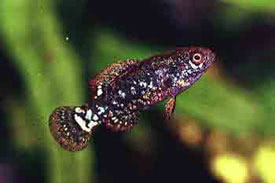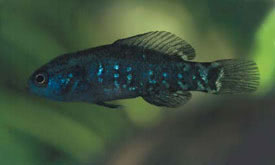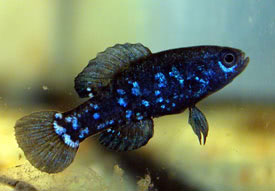
 Magyarul / Hungarian
Magyarul / Hungarian



- Scientific name: Elassoma evergladei
- Common name: Everglades pigmy sunfish, Florida pigmy sunfish
- Group: Cichlids
- Habitat: Southern parts of North America, Georgia, Florida
- Size: 3-3,5 cm.
- Biotope: Lakes, swamps and slow-moving waters.
- Social behavior: A peaceful, often timid fish, it is territorial and should be combined only with small cold water fishes.
- Diet: Carnivorous, all types of live foods including daphnia, cyclops, brine shrimp and tubifex worms. They will also accept algae and flakes.
- Breeding: Quite easy
- Tank: Minimum 30 litres
- Population: 1 male and 2 females for 30 litres
- Decoration: The fish should be kept in a species tank with a fine sandy bottom, heavily planted with cold-water plants. Add several rocks to limit territories and leave lots of open swimming space. Algae is an advatage.
- Temperature: 18-23°C
- pH: 7-7.5.
- Hardness: 8-12NK°
- Lifespan: 5-8 years
Description: It is the only pigmy sunfish with scales on the top of the head, but a microscope is needed to see them. The female has no markings and a reddish-brown body. The male has black fins, with or without brown dots; his body is black, brown, or dark green and blotched, spotted, or with a few indistinct dark bars; no black mark appears on the shoulder. Brassy to blue-green iridescent scales are lightly to densely scattered over the body, not forming bars, and two distinct light blotches occur at the root of the caudal fin.
The male's fins blacken as spawning approaches while the females are colorless. The males will establish small territoria, and defend them against intruders. Breeding is possible in a species tank if temperatures are kept between 12-25 °C. The mating ritual, which takes place among the plants, is beautiful to watch. Female lays 40-60 eggs which hatch in 2-3 days. The parents can remain; they will not harm their fry. Feed the fry fine microfood. To help the fish breed, winter them in a cool tank at 8-12 °C. The species is resistent to temperature fluctuations. They move strangely across the bottom, appearing to walk on their pectoral fins.



